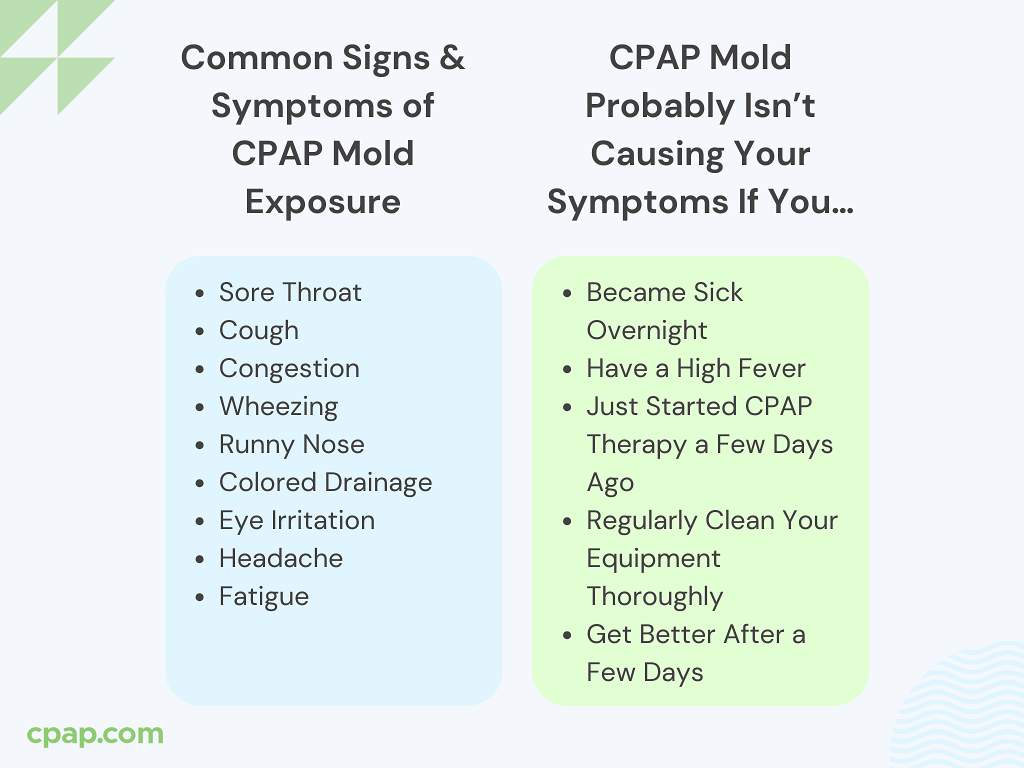
💡 Key Takeaways
- The Risks of Mold in CPAP Machines: Mold in your CPAP machine is not just an issue of cleanliness; it poses genuine health risks like respiratory and skin irritations.
- Signs of Mold Exposure: Symptoms of mold exposure can resemble those of colds or allergies, including cough and congestion. Prolonged exposure can escalate to severe conditions like pneumonia.
- How to Identify Mold: Mold in your CPAP machine can manifest as visible growth, a musty smell, or discoloration of equipment. A simple visual check is not enough due to hard-to-see areas.
- Effective Cleaning Procedures: Upon discovering mold, clean thoroughly using mild soap, warm water, and diluted vinegar. Make sure to clean all parts and allow them to fully air dry.
- Preventive Measures: Prevention involves routine cleaning according to manufacturer guidelines, using distilled water in your humidifier chamber, emptying the humidifier daily, and storing the machine in a cool, dry location.
If not cleaned properly, your CPAP machine can become a petri dish full of nasty organisms. One of the biggest concerns is mold because it can be difficult to fully get rid of and can cause irritation in your sinuses and airway.
If you think you could have mold in your CPAP, knowing what to look out for is important. And we don’t just mean how to spot it with the naked eye! CPAP machines are full of nooks and crannies that you may not be able to actually see.
Today, we’ll be talking about CPAP mold symptoms, plus other signs of CPAP mold that you should be aware of. Of course, we’ll explain how to identify mold in CPAP reservoirs, hoses, and masks and, most importantly, how to keep it from returning!
CPAP Mold Symptoms to Watch Out For

While serious complications are rare, breathing in mold from your CPAP can affect your whole body. Each time you breathe in, it pushes all those germs into your nose and airway, resulting in both short and long-term symptoms.
With mild or even moderate exposure, CPAP mold usually leads to symptoms that are often confused for a cold or allergies. On rare occasions, people can develop more serious issues, such as pneumonia. However, this is more likely to occur after long-term exposure.
At first, CPAP mold exposure triggers cough, congestion, sore throat, etc. But eventually, it can cause breathing problems, eye irritation, skin rashes, headaches, and more. In severe cases, some people develop fungal infections, with fever, body aches, and other flu-like symptoms.
Respiratory Tract Irritation
As mold spores travel through your airway, they usually cause mild to moderate irritation in your throat and lungs. Initially, mold triggers symptoms similar to pollen exposure. But, as it settles in your lungs, it causes the tissue to become irritated and inflamed. Symptoms to watch out for include:
- Sore Throat
- Cough
- Chest Congestion
- Wheezing
Sinus Irritation
Sinus irritation is a common symptom of mold exposure, but it can be particularly bad if you use a nasal CPAP mask. As CPAP air flows through your nose, it leaves traces of mold spores throughout your nasal passages, which can cause irritation early on, often in the form of:
- Runny Nose
- Post-Nasal Drip
- Sinus Congestion
- Colored Drainage
Eye and Ear Irritation
Have you ever had a sinus infection and realized your ears feel clogged? That’s because your eyes, ears, and sinuses are interconnected. When your sinuses become inflamed after exposure to CPAP mold, it can cause a domino effect that eventually affects your eyes and ears, leading to:
- Itchiness
- Redness
- Eye Watering
- Ear Pain
- Ear Inflammation
Skin Irritation
When mold comes in contact with your skin, it can cause the area to become irritated and inflamed. CPAP mold symptoms on your face may look like regular mask irritation at first, but instead of fading away after you wake up, the signs of mold irritation tend to linger:
- Itching
- Redness
- Rash
- Dry Skin
- Acne
General Symptoms
Having mold in your lungs from CPAP doesn’t just irritate your nose, throat, or airway. When you breathe in mold, it can set off a full-body response by your immune system. This can cause you to feel generally unwell, resulting in:
- Headache
- Fatigue
- Feeling Rundown
Symptoms of CPAP Mold Infection
The effects of CPAP mold are usually mild, but in some cases, it’s possible to develop an infection, such as fungal pneumonia. Mold infections are most common in people with weakened immune systems but can also develop due to repeated exposure to mold. Signs to watch for include:
- Fever
- Body Aches
- Chills
- Chest Pain
- Trouble Breathing
- Severe Chest Congestion
- Coughing Up Blood
- Wet Cough
Symptoms of Mold Toxicity from CPAP
In rare cases, mold exposure can lead to an illness called Mold Toxicity Syndrome. This serious condition arises after breathing in a large amount of mold at one time or having been regularly exposed. It typically looks and feels like:
- Brain Fog
- Migraines or Severe Headaches
- Body Aches
- Unexplained Weight Loss
- Numbness or Tingling
- Dizziness
- Significant Fatigue
- Changes in Mood
Types of CPAP Machine Mold
Realizing you have mold in your CPAP machine can be distressing, immediately triggering fears of black mold toxicity, lung damage, and permanent injury. The good news is, while it’s obviously better to have zero mold growing in your equipment, the vast majority of colonies found in your CPAP are relatively harmless and only cause mild symptoms.
Pink Mold in CPAP
If you have a CPAP machine, there’s a good chance that—at some point—you may spot pink mold growing in the CPAP reservoir, hose, or mask. Despite the name, pink mold comes in a variety of colors, including:
- Pink
- Red
- Orange
- Dark Yellow
Even in your CPAP, pink mold is rarely associated with serious illness. In fact, unless you’ve been breathing it in for an extended period, you may not even realize that you’ve been exposed to it.
Still, pink mold indicates that your CPAP needs a good cleaning. And it’s important to avoid letting it accumulate, as it can cause mild irritation or allergic reactions.
Black Mold in CPAP
When people worry about CPAP mold symptoms, it’s usually because they’ve heard the dangers of black mold. But there’s a difference between black-colored molds and toxic black molds that you hear horror stories about.
CPAP black mold is pretty similar to pink mold. While it can cause allergy-type symptoms, it is not expected to cause significant harm unless you are exposed to it for a long time. Toxic black mold is associated with old, wet buildings and is usually found in crawl spaces, basements, or attics.
Keep in mind that black-colored mold also comes in multiple colors, including:
- Black
- Green
- Blue
- Grey
If you find black mold in a CPAP machine, there’s no need to panic. But it is a sign that you should get to cleaning!
How to Tell If You Have Mold Growing in Your CPAP Machine
The easiest way to tell if you have mold growing in your CPAP is to look for mold colonies. But, while that can be helpful for black mold or pink mold, other types of mold may be harder to spot. Other signs of CPAP mold include a musty smell, equipment discoloration, or slime buildup.
It can be especially difficult to visually confirm whether or not you have mold in your CPAP mask or tube because they have inner surfaces that you may not be able to see so easily. Below are some of the other signs of mold growing in your CPAP machine.
- Musty CPAP Smell: Mold releases organic compounds that give off a strong, musty smell. If mold is causing your CPAP smell, you may notice that it’s coming from the parts of your CPAP machine that take longer to dry out after each use.
- CPAP Discoloration: Mold can stain your equipment, even after removing the colony buildup. You’re most likely to see this in the ridges of your CPAP hose, the water line of your humidifier tank, or the hidden surfaces of your CPAP mask.
- Slimy Surfaces: Mold often causes a slick or even slimy residue along the surfaces of your CPAP. This is especially common with mold in CPAP humidifier tanks.
- Visibly Dirty Equipment: While dirty equipment doesn’t necessarily mean that your equipment has mold growing in it, it is a sign that it could soon begin to develop mold if it is not cleaned properly.
How to Clean Mold from CPAP Machine
Just because you have mold in your CPAP doesn’t mean you automatically have to throw your equipment out. Unless your equipment is overrun with mold, it’s usually safe to use your CPAP again after a thorough cleaning and soaking with:
- Mild Soap
- Warm Water
- Diluted Vinegar
The keyword is thorough, though! Mold spores are microscopic and can hide in even the tiniest lips, corners, or cracks. So be prepared to put in some work when removing mold from a CPAP machine!
- Disassemble: Start by disassembling your CPAP mask, hose, filter, and water reservoir completely.
- Wash Your Equipment: Clean your CPAP by hand using mild soap and warm water.
- Add Diluted Vinegar to Disinfect: Vinegar should be diluted 2:3. Do not expose your mask cushion or filter to vinegar. All the other parts of your mask, hose, and water tank are safe to clean with diluted vinegar.
- Scrub Thoroughly: Use a small CPAP cleaning brush to scrub every surface, focusing on areas where mold growth was the worst, plus those tiny nooks and crannies you may not normally spend much time on.
- Soak for 30 Minutes: After scrubbing every inch of your equipment, leave your CPAP equipment to soak in a mixture of mild soap, warm water, and vinegar for half an hour. Set aside your mask cushion and filter to soak in just soap and water.
- Wash and Rinse: Clean your CPAP equipment one last time, rinsing each piece thoroughly.
- Air Dry: Allow everything to fully air dry out of direct sunlight before using it again.
How to Prevent Mold in CPAP Equipment
You can reduce your risk of developing CPAP mold symptoms by cleaning your equipment regularly, letting it fully air dry after each use, and replacing old or broken parts when necessary.
When using your CPAP, you should always follow your manufacturer’s cleaning and replacement instructions. However, the following rules are a good guideline for preventing CPAP mold growth:
- Clean Your Equipment Regularly: Wash your CPAP mask, tubing, water tank, and filter on schedule with warm water and mild soap. Be sure to let them dry fully before using.
- Replace Equipment on Schedule: Inspect your CPAP equipment regularly for signs of wear, damage, or deterioration. Replace your equipment as directed by your manufacturer.
- Only Use Distilled Water: Using distilled water in your CPAP is safer than tap water. Tap water can contain minerals and impurities that promote mold growth.
- Empty Humidifier Daily: Empty your humidifier daily and allow it to air dry fully to prevent mold in your water reservoir.
- Avoid Overfilling: Do not overfill your CPAP humidifier. Follow the manufacturer’s guidelines for proper water levels to limit the risk of mold in the reservoir.
- Store in a Cool, Dry Environment: It’s best to store your CPAP equipment in a cool, dry place after each use so that it can dry out. Bathrooms are not ideal for storage because they are more humid than other rooms.
- Use a CPAP Hose Hanger: Consider using a hose hanger to keep the tubing elevated and allow any remaining moisture to drain out of the hose after each use.
- Consider a CPAP Cleaner: CPAP cleaning machines sanitize your equipment, meaning they kill off all organisms living on the surfaces of your equipment. However, these cleaning machines are not a substitute for regular cleaning. While they kill germs, they do not remove the actual dirt, debris, and oils that build up over time.
- Follow Manufacturer’s Instructions: Always follow the cleaning and maintenance instructions provided by the manufacturer. They know their products best and can provide specific guidance for optimal care.
Frequently Asked Questions
Can CPAP Machines Cause Mold?
CPAP machines are an ideal location for mold growth because they are filled with moisture and warm air. Regular cleanings can prevent mold from growing in your CPAP, but if you aren’t thorough, mold can remain in the small spaces of your CPAP mask, hose, or water tank.
What Are the Symptoms of Mold Exposure from CPAP?
The symptoms of mold exposure from CPAP often include allergy symptoms, such as runny nose, sinus congestion, cough, sore throat, itchy eyes, and headache. While rare, some people develop more serious conditions, which can cause fever, chills, body aches, and a wet cough.
How Do You Get Mold Out of a CPAP Machine?
Start by washing your disassembled equipment thoroughly using a CPAP cleaning brush, mild soap, warm water, and diluted vinegar. Then, let your equipment soak in a 2:3 diluted vinegar solution for 30 minutes before cleaning again and drying.
Final Thoughts
Finding mold in your CPAP machine can be alarming, but there’s no reason to panic. Even if it’s been around for a few days, most CPAP mold symptoms are mild and resemble a minor cold or allergies. Most types of mold, including black and pink mold, can be removed and prevented with a thorough cleaning!



